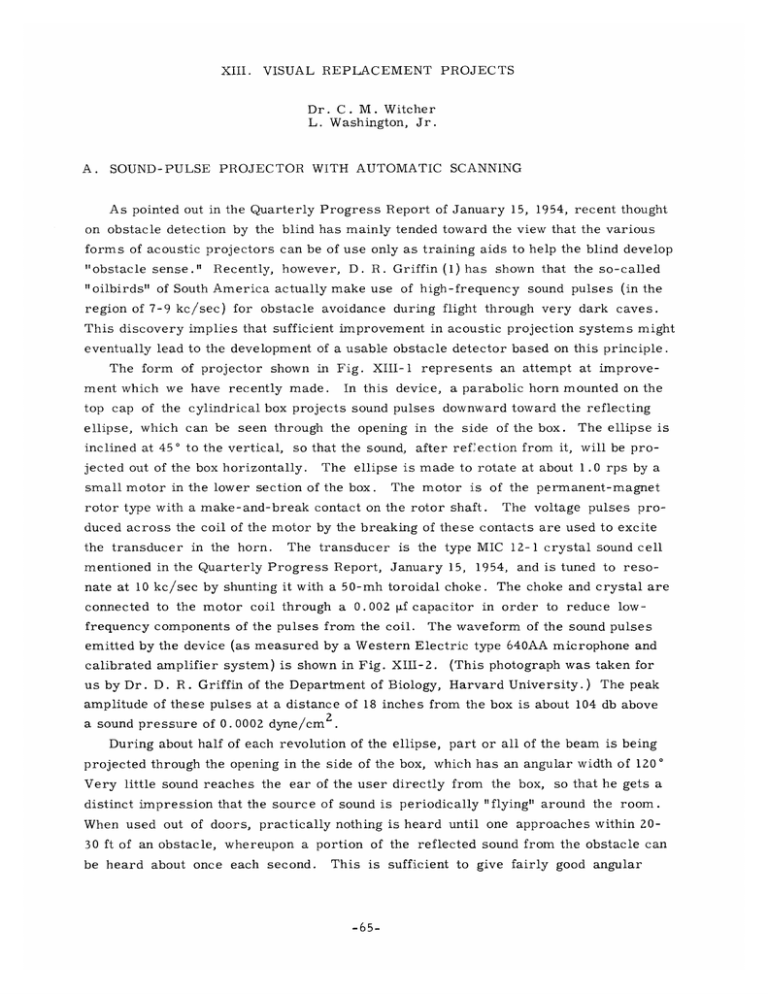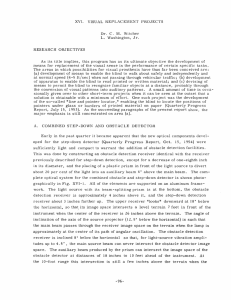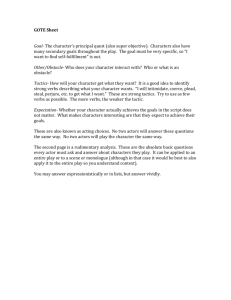XIII. VISUAL REPLACEMENT PROJECTS L. Washington, Jr.
advertisement

XIII. VISUAL REPLACEMENT PROJECTS Dr. C. M. Witcher L. Washington, Jr. A. SOUND-PULSE PROJECTOR WITH AUTOMATIC SCANNING As pointed out in the Quarterly Progress Report of January 15, 1954, recent thought on obstacle detection by the blind has mainly tended toward the view that the various forms of acoustic projectors can be of use only as training aids to help the blind develop "obstacle sense." Griffin (1) has shown that the so-called Recently, however, D. R. "oilbirds" of South America actually make use of high-frequency sound pulses (in the region of 7-9 kc/sec) for obstacle avoidance during flight through very dark caves. This discovery implies that sufficient improvement in acoustic projection systems might eventually lead to the development of a usable obstacle detector based on this principle. The form of projector shown in Fig. XIII-1 ment which we have recently made. represents an attempt at improve- In this device, a parabolic horn mounted on the top cap of the cylindrical box projects sound pulses downward toward the reflecting ellipse, which can be seen through the opening in the side of the box. The ellipse is inclined at 45 0 to the vertical, will be pro- so that the sound, after reflection from it, jected out of the box horizontally. The ellipse is made to rotate at about 1.0 rps by a small motor in the lower section of the box. The motor is rotor type with a make-and-break contact on the rotor shaft. of the permanent-magnet The voltage pulses pro- duced across the coil of the motor by the breaking of these contacts are used to excite the transducer in the horn. The transducer is the type MIC 12-1 crystal sound cell mentioned in the Quarterly Progress Report, January 15, 1954, and is tuned to reso- nate at 10 kc/sec by shunting it with a 50-mh toroidal choke. connected to the motor coil through a 0.002 The choke and crystal are f capacitor in order to reduce low- frequency components of the pulses from the coil. The waveform of the sound pulses emitted by the device (as measured by a Western Electric type 640AA microphone and calibrated amplifier system) is shown in Fig. XIII-2. us by Dr. D. R. (This photograph was taken for Griffin of the Department of Biology, Harvard University.) The peak amplitude of these pulses at a distance of 18 inches from the box is about 104 db above a sound pressure of 0.0002 dyne/cm 2 During about half of each revolution of the ellipse, part or all of the beam is being projected through the opening in the side of the box, which has an angular width of 120 Very little sound reaches the ear of the user directly from the box, distinct impression that the source of sound is so that he gets a periodically "flying" around the room. When used out of doors, practically nothing is heard until one approaches within 2030 ft of an obstacle, whereupon a portion of the reflected sound from the obstacle can be heard about once each second. This is -65- sufficient to give fairly good angular Fig. XIII-2 Waveform of sound pulses emitted by projector with 1800-cps calibration signal. ~tJ Fig. XIII-1 Sound-pulse projector with automatic scanning. Fig. XIII-3 Handle for presenting obstacle and step-down information. (XIII. localization of the obstacle, observer. VISUAL REPLACEMENT PROJECTS) along with a rough estimate of its distance from the For many obstacles, the specularity of the reflections from their surfaces materially decreases the maximum distance at which these reflections can be heard. Also, of course, the presence of considerable ambient noise may mask the reflections from all obstacles. This could be overcome to some extent by increasing the projected sound intensity, but perhaps at the cost of undue conspicuousness for the user. B. PRESENTATION OF TACTILE INFORMATION In a recent paper (2), Witcher considered the methods for tactile presentation of information which might be best suited to enable the blind to avoid obstacles while walking at a normal rate of speed (4-5 ft/sec). should include: It was concluded that this information (a) certain specific indications as to the distance of any obstacle in the region of interest, (b) other specific data regarding the angular position of the obstacle, and (c) a very distinctive indication of the presence of a step-down at a predetermined distance in front of the observer. all of these requirements. The rectangular handle shown in Fig. XIII-3 meets Four small solenoids inside this handle are provided with roundheaded plungers that press against the fingers through the small holes in one of the curved surfaces. handle, A fifth solenoid, with its axis oriented parallel to that of the is for the purpose of producing a strong vibration to indicate the presence of a step down, as in our present step-down detector. 2 inches by 0.75 inch by 3.5 inches. The dimensions of this handle are It can either be used actually as the handle of a travel aid (combined obstacle and step-down detector), or it can be attached to the device by a cable so as to be held separately in any convenient position. Any two or more signals may be fed simultaneously through this handle to the user, thus providing partial integration of the information. C. M. Witcher, L. Washington, Jr. References 1. D. R. Griffin, Acoustic orientation in the oilbirdSci. (U. S. A.) 39, 884-893 (1953). 2. C. M. Witcher, Some communication aspects of visual prosthesis, paper presented at the AAAS Meeting, Boston, 1953. -67- steatornis, Proc. Natl. Acad.







